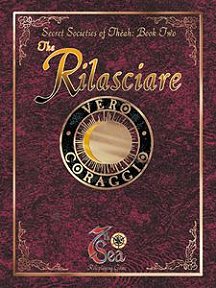
The Introduction speaks of the Rilasciare, a secret society that is quite contradictory. Viewed by many as dangerous anarchists, opponents of law and order, they see themselves as a bastion for truth and fairness, stamping out wrong-doing and corruption wherever it raises its head. Enlightened ones speaking out against outdated ideas, or a bunch of hoodlums who trample tradition underfoot with nothing to replace it? You decide...
Chapter 1: The Midnight Crusade looks at the history and organisation of the Rilasciare. It's an apt title, the Rilasciare often work at night or at least within the shadows, convinced of their own correctness they do not trouble to persuade others or even justify their actions. Although the first section is headed The Public Face, the Rilasciare don't really have one. Most regard them as a loose almost disconnected group of criminals, thinkers and reformers (the term used being based on the speaker's opinion of them!) and do not see the underlying organisation and coordination. Their aims and methods are rooted in their history, which by and large is known only to the membership. It all began with some Old Empire senators who turned to the dark arts in their quest to get rid of the current Imperator (and along the way founded the sorcerous bloodlines that spread throughout Théah) - and three senate pages who overheard them making pacts with dark powers and decided that enough was enough. Despite learning their own dark arts of poisons and assassination, they weren't getting very far... until one of them overheard the First Prophet preaching on the streets of Numa and connived to get him martyred, reasoning that such a fate would elevate a mere street preacher and his ideas (which which she agreed) to levels that mere preaching on street corners would never attain.
History rolled on and the Rilasciare with it (their name meaning 'troublemaker' in Old Théan being quite apt). Some members debated philosophy, others sought out sorcerers and brought them to account... or at least, sent them summarily to meet their makers. As the sorcerers they fought against were nobles, they often found common cause with those opposing misrule and oppression. When they wiped out some Eisen sorcerers with the help of a rival noble that didn't carry a sorcerous bloodline, they found that he was an even worse ruler than those they'd aided him to replace, and their thinking began to change: perhaps sorcery wasn't the only evil in the world. Perhaps the real enemy was those in power, however they had obtained it. The advent of the Third Prophet confirmed them in this opinion, and those who had embraced the Vaticine Church began to fall away, becoming free-thinkers. Over time, more and more turned to ideas and debate, still secret as many of the ideas might be deemed trasonous by the powers-that-be, and the violence seemed to become a thing of the past... but it did not go away entirely.
Their basic beliefs can be stated simply. Nobody should be in want. Sorcery is evil. Power corrupts, so the trappings of power must be destroyed. They seek to achieve their ends through freedom of thought, enlightened thinking - but they have not abandoned violence as a tool to accomplish their goals. They believe that all people are created equal, and nobles are not better than anybody else. There's a look at the structure of the organisation and how they work to achieve their ends in the present day. They even run schools - even if it doesn't say Rilasciare over the door! Others pull Robin Hood acts, stealing to redistribute amongst the poor, or commit acts of violence. Others remain committed to the original goal of ridding the world of sorcery. We also learn of recruitment methods and protocols. Whilst those few outsiders who know about them regard them as violent out-of-control thugs, they actually detest mindless violence - theirs is focussed with surgical precision, used only when absolutely necessary. Or so they believe.
The chapter finishes with a listing of locations and resources. Next comes Chapter 2: Hero which introduces some of the leading members of the Rilasciare. This is followed by Chapter 3: Drama, which is full of additional rules and other new material. These include a new, and rather informal, Swordsman school, rules for joining the Rilasciere and creating your own group or cell and even rules for using explosives. And, should you be interested in such things, a certain Eisen style of sorcery the Rilasciare thought they wiped out. Did the bloodline survive? Dare you play one and have the entire Rilasciare on your tail?
Finally, Chapter 4: Freemen contains a wealth of material mainly aimed at the GM (although there is a Player section as well) designed to help you bring the Rilasciare to life in your game. The GM gets the lowdown on the NPCs presented in Chapter 2, secrets and stat blocks galore, as well as advice on running a 'bomb-throwing' campaign... not to mention what to do with just one or two Freethinkers within a more conventional party. There are other ideas as well to get your creative juices going, as well as more detailed adventure hooks and the description of a prison based in a mine and no doubt very handy should some Rilasciare prank go horribly wrong...
The Rilasciare grew on me as I read this book. On the face of it they seem somewhat like a bunch of terrorists, and indeed they could be played that way if you are looking for a persistent enemy for more law-abiding heroes (an option that rather surprisingly is not considered). If your players have an anarchic streak, however, at least one might be open to recruitment or you may opt for a Rilasciare-based campaign. There's more to them than meets the eye!
Return to The Rilasciare page.
Reviewed: 9 January 2017

